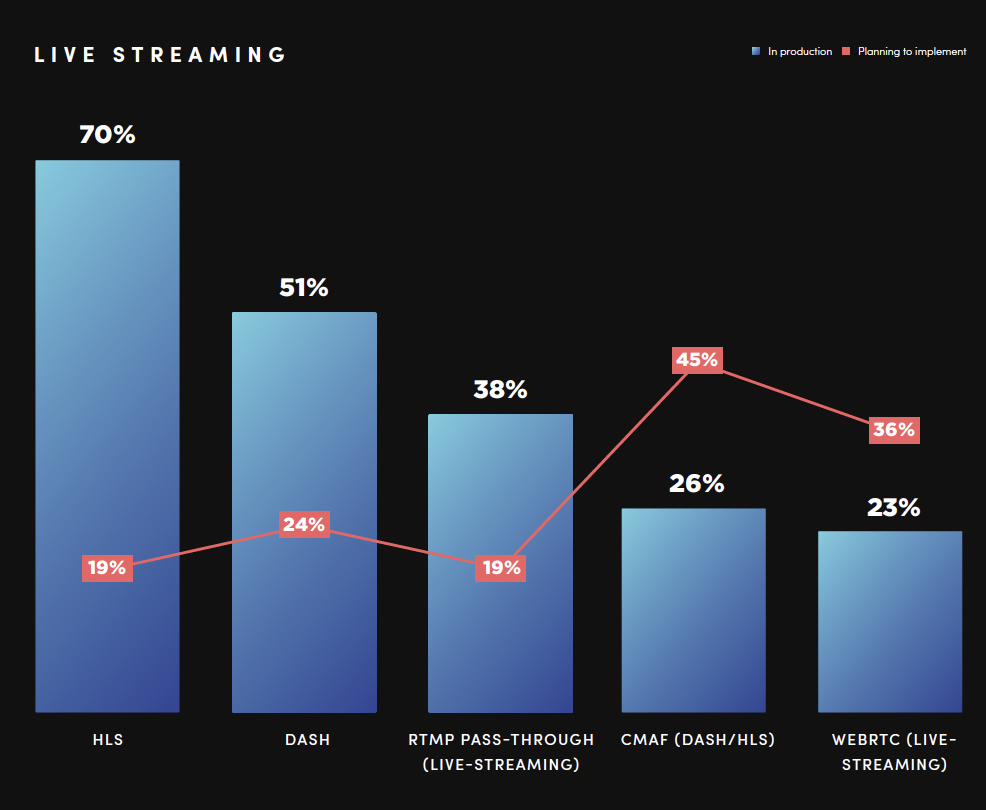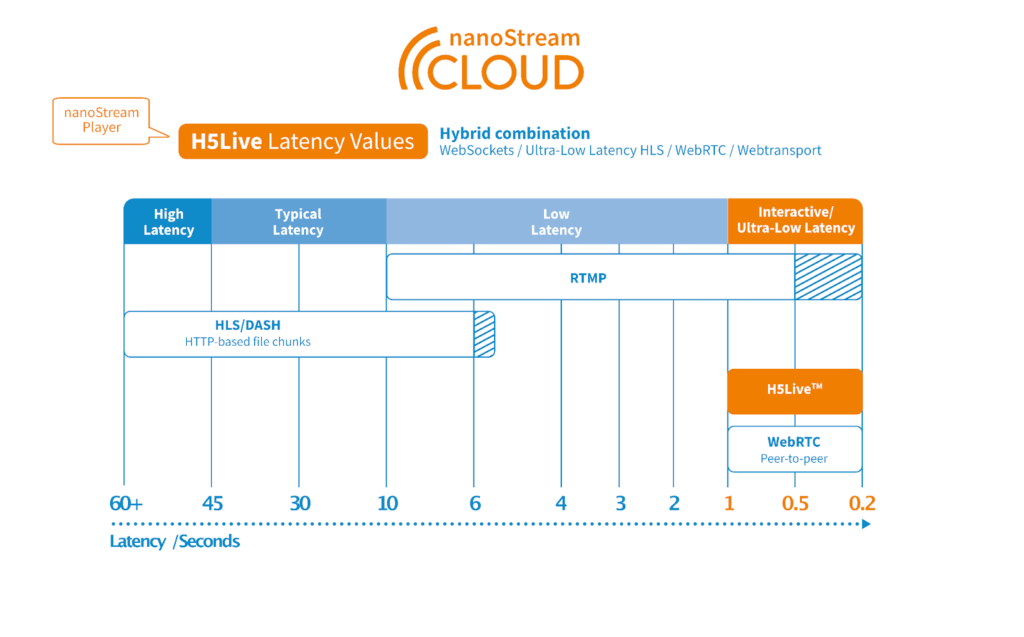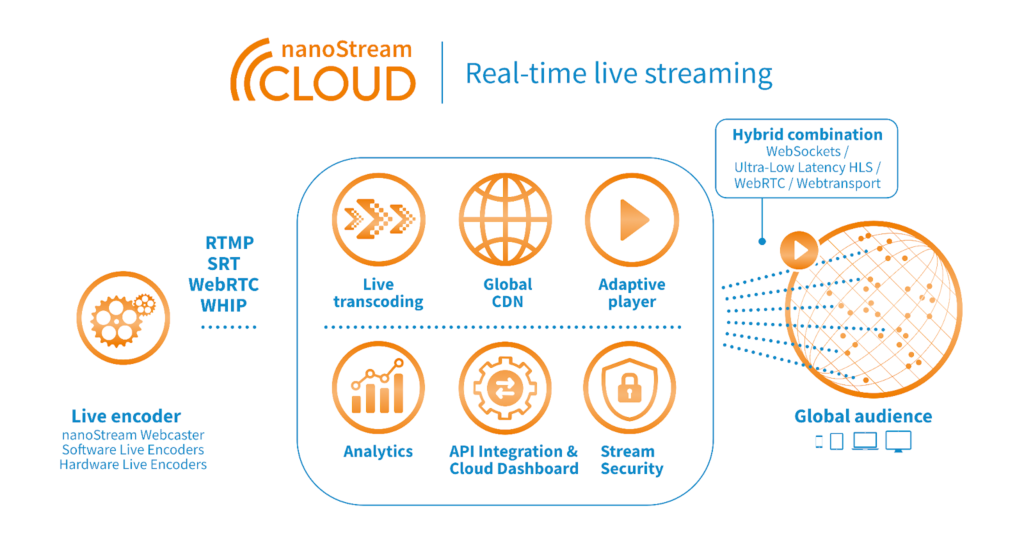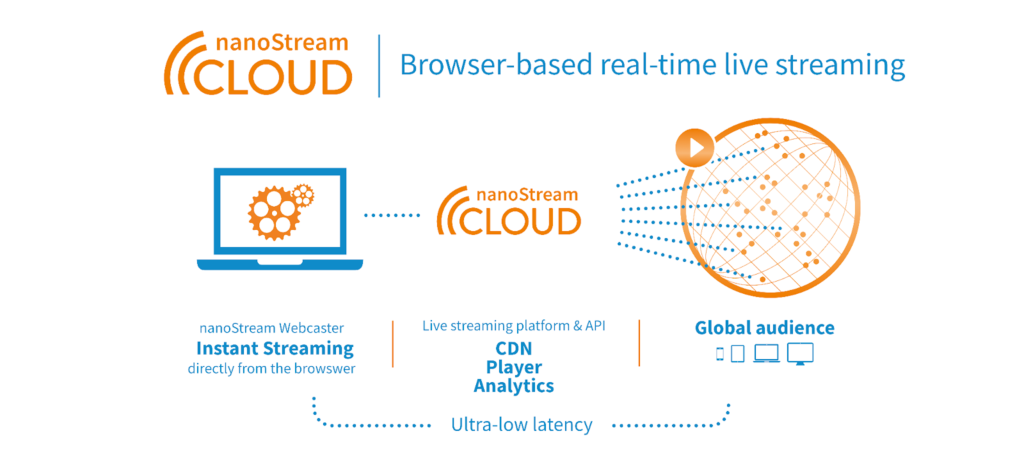When it comes to video communication and conferencing applications for interactive live streaming applications, Web Real-Time Communications (WebRTC) is a proven technology for speedy video delivery. The lightning-fast format powers countless browser-based applications like the Open Source video meeting tools Jitsi Meet, Big Blue Button, and commercial applications like Slack and Amazon Chime.
WebRTC can reduce the stream latency compared to other formats, which is important for audience engagement with realtime interaction.
So what’s the secret sauce behind WebRTC’s ultra-low-latency capabilities and how does it compare to other streaming protocols? Which challenges are there, and which solutions? We cover it all in this article.
What Is WebRTC?
WebRTC delivers near-instantaneous audio and video streams to and from any major browser. As a plugin-free technology, it also eliminates the need for third-party player software and encoding hardware.
The framework’s combination of standards, protocols, and JavaScript APIs make it a popular option for developers looking to replicate in-person interactions online. All you need is your browser to capture, encode, and transmit live video streams when using WebRTC. As a result, broadcasting immersive experiences can be as easy as just a few clicks (and some coding know-how).
For this reason, many developers have built click-to-start video environments using WebRTC. But that’s not to say that the open framework is without limitations. Creating an application layer around it is complex. Snd because WebRTC was designed for chat-based collaboration between a handful of participants, challenges can arise when adapting it to different use cases with larger audiences.
What Is WebRTC Latency?
WebRTC latency — or the delay between when a video is captured and played back on a viewer’s device — typically clocks in at sub-500 milliseconds (or .5 seconds). This makes it one of the speediest streaming technologies out there and a popular choice for building interactive online environments.
However, this latency is not guaranteed in all situations, and it’s only possible in workflows that use WebRTC from end-to-end (often without an intermediary streaming server or service). For instance, many live chatting apps leverage WebRTC to power real-time collaboration.
When WebRTC is used for large-scale broadcasting, it’s necessary to bring additional infrastructure and streaming formats into the mix that support large-scale distribution. In these cases, the latency can range anywhere from .5 seconds to 60 seconds.
Why would such an expansive range result from adapting WebRTC to broadcast-based workflows? To explain, we’ll need to take a look at other streaming protocols out there and WebRTC’s limitations.
WebRTC Challenges and How to Solve Them
- Scalability: As a peer-to-peer technology, WebRTC wasn’t designed for large-scale broadcasting. That means, you’ll need to transcode it into an alternative protocol when streaming to more than 50 concurrent connections.
- Quality: Because WebRTC achieves ultra low latency by adjusting the stream quality to the network conditions of the sender and receiver, quality is determined by the viewer with the worst network condition. This makes quality suffer in one-to-many delivery. By ingesting WebRTC streams and then transcoding into ABR, broadcasters can decouple the ingest quality from network conditions on the viewer side and control latency via adaptive delivery.
How Does WebRTC Latency Compare to Other Streaming Protocols?
When asked which protocols they use for live streaming, the majority of participants in Bitmovin’s 2022/2023 Video Developer Report indicated they had high-latency HLS and DASH in production. On the flip side, low-latency CMAF and WebRTC were the formats that most developers indicated they were planning to implement.

This reflects an industry-wide move toward lower-latency formats. That’s because, although HLS and DASH will remain popular formats for the foreseeable future, they simply aren’t suitable for applications like live betting and town hall meetings where time is of the essence. And increasingly, these interactive applications are where the industry is headed.
WebRTC vs. HLS vs. RTMP and More
| HLS and MPEG-DASH | RTMP and RTSP | WebRTC | H5Live | |
| Latency | 6-60 seconds, with 6 seconds only possible when tuned for reduced latency. | 5 seconds or less. | Sub 500 milliseconds (can also go higher based on the configuration). | Sub-second end to end. |
| Delivery Method | TCP | TCP | UDP | TCP / UDP (hybrid combination- WebSockets, Ultra-Low-Latency HLS, WebRTC, Webtransport) |
| Compatibility | Ubiquitously supported across end-user devices and browsers (but iOS and Apple TV do not natively support DASH). | No longer accepted by most browsers, embeddable players, or devices. | Chrome, Firefox, and Safari support WebRTC without any plugins. | Ubiquitously supported across end-user devices and browsers. |
| Scalability | As cacheable segment-based HTTP protocols, HLS and DASH can easily be scaled across a CDN. | Not supported by CDNs for delivery, but still widely used for ingest. | As a peer-to-peer technology, WebRTC wasn’t designed to scale to more than 50 concurrent connections. | nanoStream CDN is integral part of the solution, which also supports adaptive bitrate delivery (ABR). |
| Use Case | One-way broadcasts where latency doesn’t matter. | RTMP is the industry standard Ingest protocol; whileRTSP supported IP camera surveillance systems and video contribution. | Small-scale interactive environments or real-time video contribution to a streaming service like nanoStream Cloud, or vendor-specific solutions | Large-scale interactive environments like igaming, townhalls, live auctions, virtual marketplaces, sports betting, and more. |
Let’s break it down:
- HLS and MPEG-DASH: These HTTP-based protocols support reliable streaming to any device and can be distributed across web servers for limitless scalability. While it’s possible to tune the protocols for as low as six seconds of latency, this introduces complexity and compromises reliability. You’re best off using HLS and DASH when latency serves no benefit — such as one-way streams and linear programming.
- RTMP and RTSP: As long-standing technologies in the video streaming space, RTMP and RTSP often play a role in video contribution. Also called ingest, this describes the process of transporting a live stream from the camera or source device to a streaming platform like nanoStream Cloud. Most content distributors then repackage RTMP streams into a different protocol that can be played back on end-user devices. This extra step can introduce latency, but it isn’t something you’d want to skip. No browsers and most user devices today don’t natively support RTMP playback.
- H5Live: One of the only technologies out there that can compete with WebRTC in terms of delivery speed is our very own H5Live technology. It’s also supported by all HTML5 browsers. Based on WebSockets, Low-Latency HLS, and fragmented MP4, H5Live ensures sub-second streaming at scale. Rather than being a proprietary technology, it intelligently matches the end-users device with one of these formats and can be easily embedded in any browser.
Do I always need low latency protocols? No! Think about valuable use cases for monetizing low latency live streaming: audience engagement, Q&A, voting, polling, live auctions, betting, shopping, gaming, gambling.

WebRTC vs. H5Live
As you can see in the graphic above, WebRTC and H5Live are the best options available for interactive and ultra-low latency streaming. But because WebRTC is only a technology component and not a complete solution, it runs into issues when streaming to large audiences on any network or device across the globe. H5Live, on the other hand, helps address these shortcomings by employing highly-available HTML5 technologies.
Having said all this, it’s not only about finding the right streaming protocol. There are many challenges when delivering video, and the streaming technology only one of them. You need a complete CDN and full control over all components and data insights to maintain quality. Thinking about your workflow holistically is required to create a proven application with a great user experience
Luckily, with nanostream Cloud, you don’t have to choose just one protocol. The comprehensive platform provides a fully scalable system with the flexibility of easy integration into custom applications.

Low-Latency Streaming Use Cases for WebRTC and H5Live
So who should be prioritizing low-latency streaming technologies like WebRTC and H5Live? It all has to do with your specific use case.
As a general rule of thumb: The more passive a broadcast is, the more delay it can handle. But when you get into distributing interactive content like in the examples below, timely video delivery is key to the viewing experience.
- Town hall meetings: As more organizations have made the shift to remote work, virtual town halls have become a crucial way of maintaining two-way communication across the workforce. Without interactive features to collect feedback, host Q&As, engage participants in polls, and the like — these do little to replicate the true value of an in-person forum. That’s why ultra-low-latency technologies like WebRTC and H5Live are table stakes for hosting engaging virtual town halls.
- Live auctions: With online auctions and online marketplaces, any video delay could mean the difference between an item going unsold and a full-on bidding war. Fractions of seconds cost thousands when money is on the line. To successfully bring your auctions online, you’ll need to combine real-time interactivity, scalability, and mobile-friendly playback. And for that, you’ll need nanocosmos.
- Online betting and igaming: Today’s online betting environments lure in participants because of their fast pace. Everything from horse tracks and basketball games to casinos and bingo halls have moved online to reach gamblers. Real-time streaming underpins these dynamic environments by providing a seamless experience for participants.
How to Stream Low-Latency WebRTC at Scale With Nanocosmos
At nanocosmos, we work with organizations across industries to deliver the cutting-edge streaming technology that today’s virtual environments require. Recognizing the scalability issues that WebRTC presented, we designed a solution that combined the low-latency, plugin-free benefits of WebRTC with global streaming to giant audiences.
We integrate WebRTC on the ingest / contribution part of the interactive live streaming workflow. nanoStream enables WebRTC ingest from any web browser on desktop or mobile, or a WHIP client like OBS or Osprey video (a technology partner of nanocosmos with validated hardware encoders).

By using nanoStream Webcaster with nanoStream Cloud, you’re able to go live directly from your web browser. From there, your streams can be distributed via H5Live for sub-second streaming delivery to massive audiences worldwide.
nanoStream Cloud can also be integrated with video meeting applications like Zoom or Jitsi Meet.
Architecting interactive live streaming deployments with ultra-low-latency is about more than just selecting the right protocols. Your configuration, network, server infrastructure, CDN, player, encoder, data insight, and security all impact the end-user experience. That’s why organizations rely on nanocosmos to provide a comprehensive solution that ensures great audience experience.
With nanoStream Cloud, you’ll benefit from:
- Global Content Delivery Network (CDN): With 100% uptime and continuous 24/7 operations, our low-latency CDN guarantees high availability with no interruptions, no matter how many people tune in. That means your users can engage from every corner of the globe.
- Dynamic Real-Time Player: Our easy-to-embed player combines seamless playback with sub-second latency — delivering on all your viewers’ expectations and more.
- Advanced Analytics: Harness the power of our analytical tools to derive meaningful insights. By using the nanocosmos platform from end to end, you’ll gain observability across the workflow to inform business decisions.
- Flexible Integration: Takes your RTMP, SRT, WebRTC, WHIP Live Stream supported by our APIs and Dashboards to integrate with global live streaming easily..
So what are you waiting for? Start a free trial today to see low-latency WebRTC in action using nanoStream Cloud.
Additional Information
- How to use OBS for Low Latency Live Encoding to nanoStream Cloud
- Ultra Low Latency with nanocosmos by Robert Reinhardt
